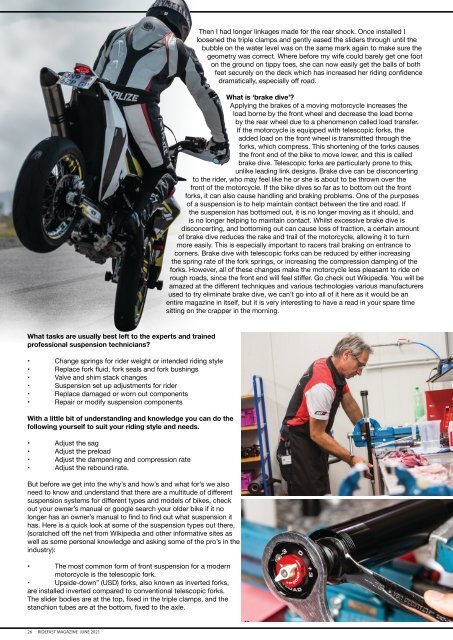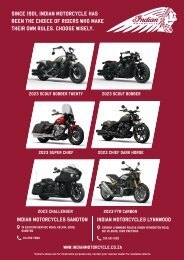RideFast JUNE 2021
You also want an ePaper? Increase the reach of your titles
YUMPU automatically turns print PDFs into web optimized ePapers that Google loves.
Then I had longer linkages made for the rear shock. Once installed I<br />
loosened the triple clamps and gently eased the sliders through until the<br />
bubble on the water level was on the same mark again to make sure the<br />
geometry was correct. Where before my wife could barely get one foot<br />
on the ground on tippy toes, she can now easily get the balls of both<br />
feet securely on the deck which has increased her riding confidence<br />
dramatically, especially off road.<br />
What is ‘brake dive’?<br />
Applying the brakes of a moving motorcycle increases the<br />
load borne by the front wheel and decrease the load borne<br />
by the rear wheel due to a phenomenon called load transfer.<br />
If the motorcycle is equipped with telescopic forks, the<br />
added load on the front wheel is transmitted through the<br />
forks, which compress. This shortening of the forks causes<br />
the front end of the bike to move lower, and this is called<br />
brake dive. Telescopic forks are particularly prone to this,<br />
unlike leading link designs. Brake dive can be disconcerting<br />
to the rider, who may feel like he or she is about to be thrown over the<br />
front of the motorcycle. If the bike dives so far as to bottom out the front<br />
forks, it can also cause handling and braking problems. One of the purposes<br />
of a suspension is to help maintain contact between the tire and road. If<br />
the suspension has bottomed out, it is no longer moving as it should, and<br />
is no longer helping to maintain contact. Whilst excessive brake dive is<br />
disconcerting, and bottoming out can cause loss of traction, a certain amount<br />
of brake dive reduces the rake and trail of the motorcycle, allowing it to turn<br />
more easily. This is especially important to racers trail braking on entrance to<br />
corners. Brake dive with telescopic forks can be reduced by either increasing<br />
the spring rate of the fork springs, or increasing the compression damping of the<br />
forks. However, all of these changes make the motorcycle less pleasant to ride on<br />
rough roads, since the front end will feel stiffer. Go check out Wikipedia. You will be<br />
amazed at the different techniques and various technologies various manufacturers<br />
used to try eliminate brake dive, we can’t go into all of it here as it would be an<br />
entire magazine in itself, but it is very interesting to have a read in your spare time<br />
sitting on the crapper in the morning.<br />
What tasks are usually best left to the experts and trained<br />
professional suspension technicians?<br />
• Change springs for rider weight or intended riding style<br />
• Replace fork fluid, fork seals and fork bushings<br />
• Valve and shim stack changes<br />
• Suspension set up adjustments for rider<br />
• Replace damaged or worn out components<br />
• Repair or modify suspension components<br />
With a little bit of understanding and knowledge you can do the<br />
following yourself to suit your riding style and needs.<br />
• Adjust the sag<br />
• Adjust the preload<br />
• Adjust the dampening and compression rate<br />
• Adjust the rebound rate.<br />
But before we get into the why’s and how’s and what for’s we also<br />
need to know and understand that there are a multitude of different<br />
suspension systems for different types and models of bikes, check<br />
out your owner’s manual or google search your older bike if it no<br />
longer has an owner’s manual to find to find out what suspension it<br />
has. Here is a quick look at some of the suspension types out there,<br />
(scratched off the net from Wikipedia and other informative sites as<br />
well as some personal knowledge and asking some of the pro’s in the<br />
industry):<br />
• The most common form of front suspension for a modern<br />
motorcycle is the telescopic fork.<br />
• Upside-down” (USD) forks, also known as inverted forks,<br />
are installed inverted compared to conventional telescopic forks.<br />
The slider bodies are at the top, fixed in the triple clamps, and the<br />
stanchion tubes are at the bottom, fixed to the axle.<br />
26 RIDEFAST MAGAZINE <strong>JUNE</strong> <strong>2021</strong>


















